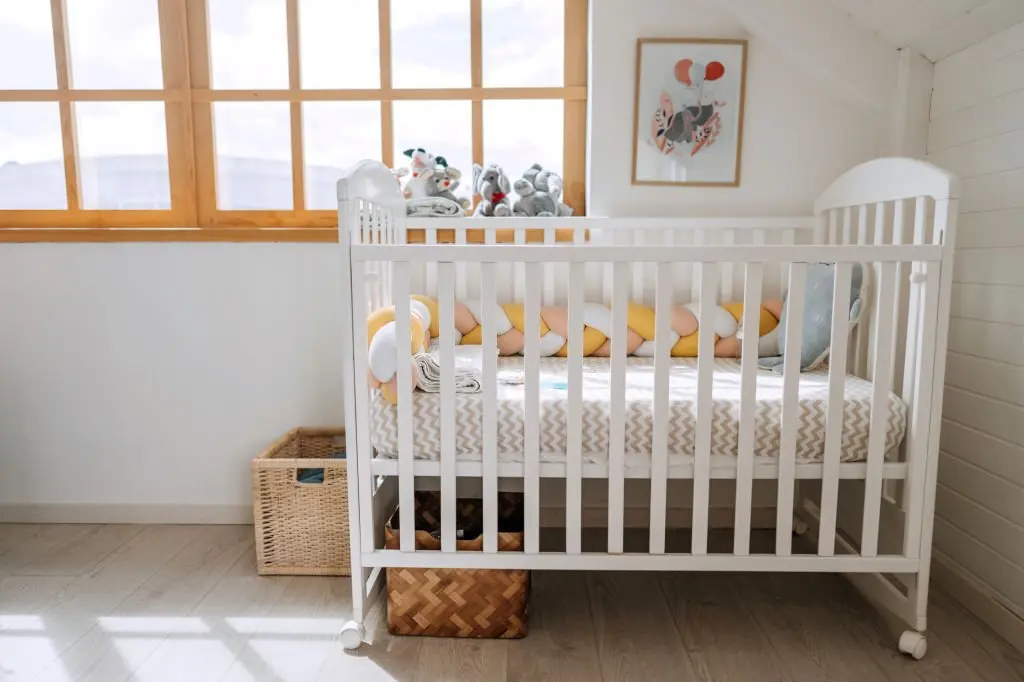The Best Crib: What To Look For When Buying a Crib

What to look for in a crib: Introduction
The baby crib is one of the most crucial purchases when preparing for a new baby. It’s not just about aesthetics or fitting into your nursery’s theme; more importantly, it’s about safety and comfort. So, what should you look for in a crib? Let’s dive deep into the essential features and considerations.
What to look for in a crib

Choosing a crib can be overwhelming, with so many options available. However, focusing on the following features can help narrow down your choices and ensure you pick the best for your baby.
1. Baby crib safety standards
Safety should always be the top priority when selecting a baby crib. After all, your baby will spend significant time in it.
- Certifications: Certifications like JPMA (Juvenile Products Manufacturers Association) or ASTM (American Society for Testing and Materials) ensure that the crib meets or exceeds current safety standards. These certifications are a testament to the crib’s quality and safety features. Always check for these labels when shopping.
- Slats Distance: The distance between slats is crucial. Slats should be no more than 2 3/8 inches apart to prevent the baby’s head from getting trapped. This measurement ensures that your baby can’t accidentally stick their head or limbs between the slats, which could lead to injury.
2. Material and build
The crib’s material and build quality directly influence its durability and safety.
- Solid Wood vs. Manufactured: Solid wood cribs tend to be sturdier and longer-lasting. They’re often more resistant to wear and tear compared to manufactured wood. However, ensure any paint or finish is non-toxic, as babies often chew on crib rails when teething.
- Hardware: It’s essential to check for sharp edges or protruding screws. These can be potential hazards. Regularly inspect the crib’s hardware to ensure everything remains tight and in place.
3. Adjustability
As your baby grows, their needs change. A crib that can adapt is both practical and cost-effective.
- Mattress Height: The ability to adjust the mattress height is invaluable. When babies are younger and less mobile, a higher mattress makes it easier for parents to pick them up. However, as they grow and begin to stand or try to climb, lowering the mattress ensures they can’t tumble out.
- Convertible Options: Some cribs can convert into toddler or full-sized beds. This feature means that your initial investment can last well beyond the baby years, offering excellent value for money.
4. Size and fit
The crib’s size should fit your space and suit your baby’s needs.
- Standard vs. Mini: Depending on your space, you might opt for a standard or mini crib. While standard cribs offer more space for your growing baby, mini cribs can be perfect for smaller rooms or parents who prefer co-sleeping arrangements.
- Portability: Cribs with wheels or those designed to be easily moved can be handy, especially if you want to shift the baby between rooms.
5. Design and Aesthetics
While safety and functionality are paramount, design and aesthetics are also essential.
- Style: Every nursery theme has a crib style, From vintage to modern. Whether for a rustic farmhouse look or a sleek contemporary design, a crib fits the bill.
- Color Choices: While white and wood tones are classic, don’t be afraid to explore cribs in bolder colors or finishes. They can add a pop of personality to your nursery.
6. Price and brand reputation
Quality doesn’t always have to break the bank, but being informed is essential.
- Budget: Cribs range from budget-friendly to luxury. It’s crucial to decide on a budget and stick to it. However, never compromise on safety features for the cost.
- Reviews: Always check reviews and brand reputation before making a purchase. Past buyers’ experiences can offer invaluable insights.
7. Additional features
These are the bells and whistles that, while not essential, can make life a tad easier.
- Storage: Some cribs come with built-in drawers, which can be handy for storing baby essentials like diapers or bedding.
- Teething Rails: These are protective covers on the crib’s rails. When your baby starts teething, they protect the crib and ensure it doesn’t ingest wood or paint.
8. Ease of assembly
A crib that’s easy to assemble can save a lot of stress.
- Instructions: Clear instructions and labeled parts can make the assembly process is smoother. It’s also beneficial if customer service is accessible for any queries.
- Required Tools: Ideally, the crib should have all the necessary tools. If not, knowing what you need in advance can save last-minute trips to the hardware store.
9. Mattress considerations
The mattress is as crucial as the crib.
- Firmness: A firm mattress is recommended for infants to reduce the risk of SIDS (Sudden Infant Death Syndrome).
- Waterproof: Babies are messy. A waterproof mattress or cover can make clean-ups easier and ensure longevity.
10. Warranty and return policy
Always read the fine print.
- Duration: A longer warranty can indicate a manufacturer’s trust in their product. It also offers you protection against defects or issues.
- Coverage: Understand what’s covered, from defects to wear and tear. Some warranties might also offer replacements or refunds.
Conclusion on what to look for in a crib
Choosing the right crib combines safety considerations, personal aesthetics, and practical features. Understanding what to look for in a crib can ensure your baby has a safe and comfortable resting space, giving you peace of mind.
Remember, while design and style are essential, safety should always be the top priority. As you embark on this exciting journey of parenthood, making informed decisions will always serve you and your little one best.
Also Read:
- Is It Safe to Hang Pictures Above a Crib?
- How to Make Baby More Comfortable in Crib
- How to Prevent Baby From Hitting Head on Crib
- How To Keep Baby From Rolling Over In The Crib An Ultimate Guide
FAQs on what to look for in a crib
Why are safety certifications important for cribs?
Safety certifications, such as those from JPMA or ASTM, ensure that the crib has undergone rigorous testing and meets specific safety standards. These certifications provide peace of mind for parents, knowing that the product they’re purchasing adheres to industry-set guidelines and has been deemed safe for infant use. It’s always a good idea to prioritize products with recognized safety certifications to ensure the utmost safety for your little one.
Can I use a second-hand crib?
While buying a second-hand crib might be cost-effective, it comes with risks. Older cribs might not meet current safety standards, and there’s also the potential for wear and tear that could compromise the crib’s safety. If you’re considering a used crib, always check for recalls, ensure it’s in good condition, and verify that it adheres to modern safety guidelines. Remember, safety comes first!
How often should I check the crib’s hardware?
Regular maintenance is essential for any piece of furniture, especially something as crucial as a baby’s crib. It’s advisable to inspect the crib’s hardware monthly for any loose screws or parts, especially if it’s frequently moved or adjusted. This routine check ensures that everything remains tight and in place, reducing any potential hazards.
When should I lower the crib’s mattress?
As your baby grows and becomes more mobile, their crib needs will change. Once your baby can sit or pull themselves up, usually around 6-9 months, it’s time to lower the mattress. This adjustment prevents them from climbing or falling out of the crib. It’s always better to be proactive in this regard to ensure safety.
Is a convertible crib worth the investment?
Convertible cribs, which can transform into toddler or even full-sized beds, offer longevity. While the initial investment might be higher, they can provide a cost-effective solution in the long run, transitioning with your child from infancy to toddler years and beyond. For parents looking for a long-term solution, convertible cribs are a worthy consideration.
How do I ensure the paint or finish is non-toxic?
When shopping for a crib, look for labels or certifications that guarantee the use of non-toxic paints and finishes. Babies often chew on crib rails when teething, so ensuring the materials are safe for ingestion is essential. Checking for certifications and reading product descriptions carefully can clarify this front.
